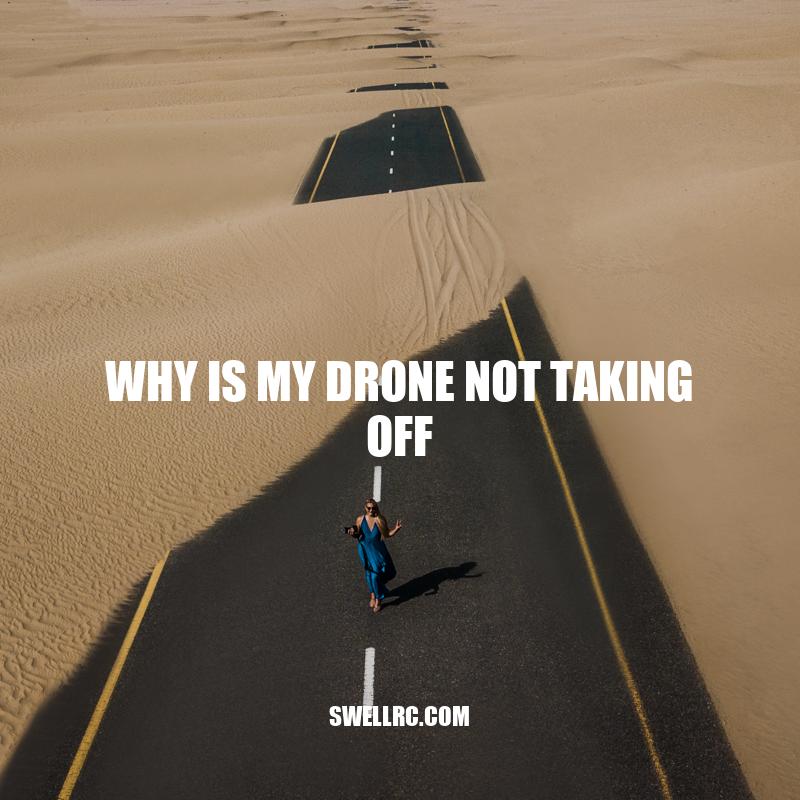Troubleshooting: Reasons Your Drone Won’t Take Off
Drones have become increasingly popular over the years, and it’s not hard to see why. From capturing stunning aerial footage to delivering packages, drones have a wide range of applications. However, when your drone fails to take off, it can be frustrating and confusing. There are several reasons why a drone might not take off, and it’s important to identify and troubleshoot the issue before attempting to fly the drone again. In this article, we’ll take a look at some of the most common reasons why a drone might not take off and provide tips on how to troubleshoot these issues. Whether you’re a seasoned drone pilot or a beginner, understanding the reasons why a drone might not take off can help you better care for your drone and ensure a successful flight.
Battery Related Issues
One of the most common reasons why a drone might not take off is a low or malfunctioning battery. Here are some tips to troubleshoot battery-related issues:
- Ensure that the battery is properly charged and installed
- Check the battery connections and make sure they are clean and secure
- Use the manufacturer’s recommended battery for your drone
If you’ve tried the above tips and still encounter a battery-related issue, consider reaching out to the drone’s manufacturer for support. You may also want to invest in a replacement battery, which can typically be found on the manufacturer’s website or on websites like Amazon or Best Buy.
How do you troubleshoot a battery problem?
Here are some quick steps to troubleshoot battery problems:
- Check if the battery is properly plugged in and connected to the device.
- Check if the charger is working properly.
- Make sure there are no software issues draining the battery.
- Try restarting the device.
- If the above steps don’t work, replace the battery or take the device to a professional for further assistance.
If you are experiencing battery problems with a specific product, check the manufacturer’s website for troubleshooting tips or contact their customer support for assistance.
Obstacle Detection Interference
Obstacle detectors are a safety feature that some drones have to prevent collisions. However, these sensors can sometimes interfere with takeoff if they detect an obstacle that isn’t there. It can cause the drone to stop automatically, not allowing it to take off. If you’re experiencing this issue, here are some troubleshooting tips:
- Check if the obstacle detection sensors are clean and not obstructed by dirt or debris
- Disable the obstacle detection feature in the settings
- Recalibrate the drone sensors by following the manufacturer’s instructions
It’s important to note that disabling the obstacle detection feature can be risky and may result in collisions. Always fly your drone in a safe environment and use caution when turning off safety features.
If you’re interested in purchasing a drone with obstacle detection, some popular options include:
| Drone Model | Obstacle Detection Type | Price Range |
|---|---|---|
| DJI Mavic Air 2 | Forward, backward and downward obstacle sensors | $799 – $988 |
| Autel Robotics EVO II | Front, rear, left, right and downward vision sensors | $1,195 – $1,795 |
| Holy Stone HS720 | Downward obstacle sensors | $299 – $349 |
Which sensor is used for obstacle detection?
There are various sensors that can be used for obstacle detection including:
- Ultrasonic sensors
- Infrared sensors
- Laser range finders
- LiDARs
- Radar sensors
- 3D cameras
These sensors are commonly used in autonomous vehicles, robotics and industrial automation. The choice of sensor depends on factors such as the application, range of detection, accuracy, and cost.
Calibration Issues
Calibration is an important step to ensure that your drone’s compass and other sensors are working properly. Here are some tips to troubleshoot any calibration issues:
- Make sure that your drone is on a flat surface and there is no magnetic or electromagnetic interference around you
- Follow the calibration instructions provided by the drone manufacturer
- If you’re still facing issues, reset the drone to default settings and try calibrating again
If you’re looking to purchase a drone that’s easy to calibrate, consider the DJI Mavic Air. The DJI Mavic Air has a built-in self-diagnostic system that checks for sensor errors and suggests solutions.
If you’re not confident in your ability to troubleshoot calibration issues, seek professional help. Some drone manufacturers offer repair services and support, and there are also online resources such as the DJI Forum where you can find help from other drone pilots.
What can affect calibration?
There are several factors that can affect calibration, including:
- Changes in the environment, such as temperature, humidity, and altitude.
- Wear and tear on the equipment being calibrated.
- Incorrect handling, storage or transportation of the equipment.
- Improper calibration procedures or methods used.
- Malfunctioning or inaccurate calibration equipment.
It is important to maintain proper calibration to ensure accurate measurements and prevent costly errors. Regular calibration checks and proper handling of equipment can help minimize any potential calibration issues. If you are experiencing calibration issues, consider contacting a professional calibration service or checking the manufacturer’s website for troubleshooting tips or product support.
Environmental Factors
Flying a drone in extreme weather conditions or locations can negatively impact its performance, causing it to not take off. Here are some environmental factors to consider:
- High winds or gusts can make it difficult for the drone to fly or maintain its position
- Heavy rain or snow can damage the drone’s sensitive components and affect its electrical circuitry
- Extreme temperatures can affect the battery life of the drone, causing it to shut down prematurely
- Electromagnetic interference from power lines, cell towers, or other electronic devices can affect the drone’s GPS signals and cause it to malfunction
Before flying your drone, make sure to check the weather forecast and avoid flying in inclement weather. Storing your drone properly and avoiding exposure to extreme temperatures will also help prolong its lifespan.
When choosing a location to fly your drone, avoid areas with power lines and other sources of electromagnetic interference. Check with your local authorities for drone flying regulations and guidelines. You can also use online resources such as AirMap to find drone-friendly locations and check for any restrictions or hazards in the area.
What are the 5 environmental factors?
The following are the five environmental factors that can affect an organism’s survival and growth:
- Temperature
- Light
- Water
- Air
- Soil
Understanding and addressing these factors can be essential for creating and maintaining healthy living environments for both humans and other forms of life.
For more information on environmental factors and how they impact our lives, check out relevant websites such as the EPA’s Environmental Topics page or product resources such as eco-friendly guides for household items or personal care products.
Conclusion
In conclusion, there are several reasons why your drone might not be taking off. Troubleshooting the issue by checking the battery, sensors, and the environment can help identify and solve the problem. Always follow the manufacturer’s instructions and safety guidelines when operating your drone. If you are still experiencing issues with your drone, seek professional help from the manufacturer or a qualified drone technician. In some cases, the drone may need to be repaired or replaced. By taking proper care of your drone and addressing any issues promptly, you can ensure a safe and enjoyable flying experience. Remember to always fly responsibly and obey local regulations to ensure the safety of yourself and others.



